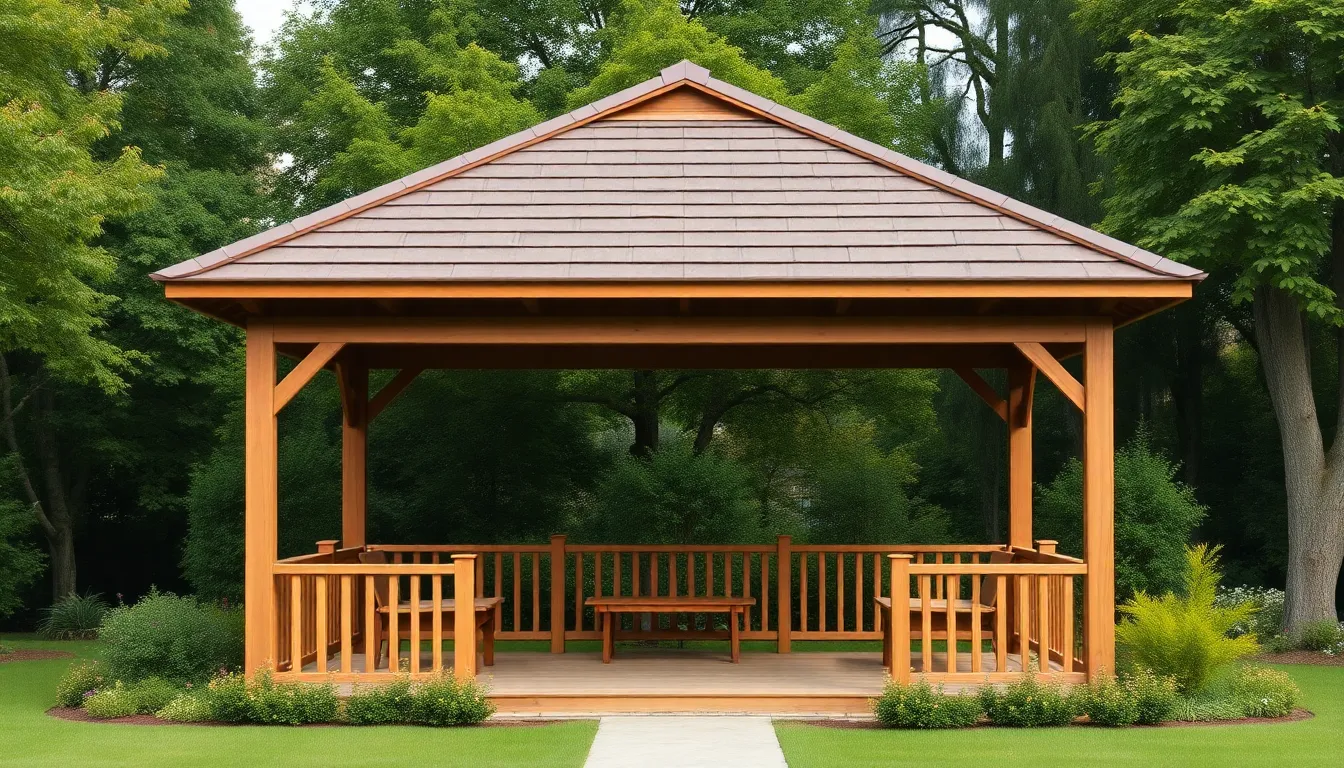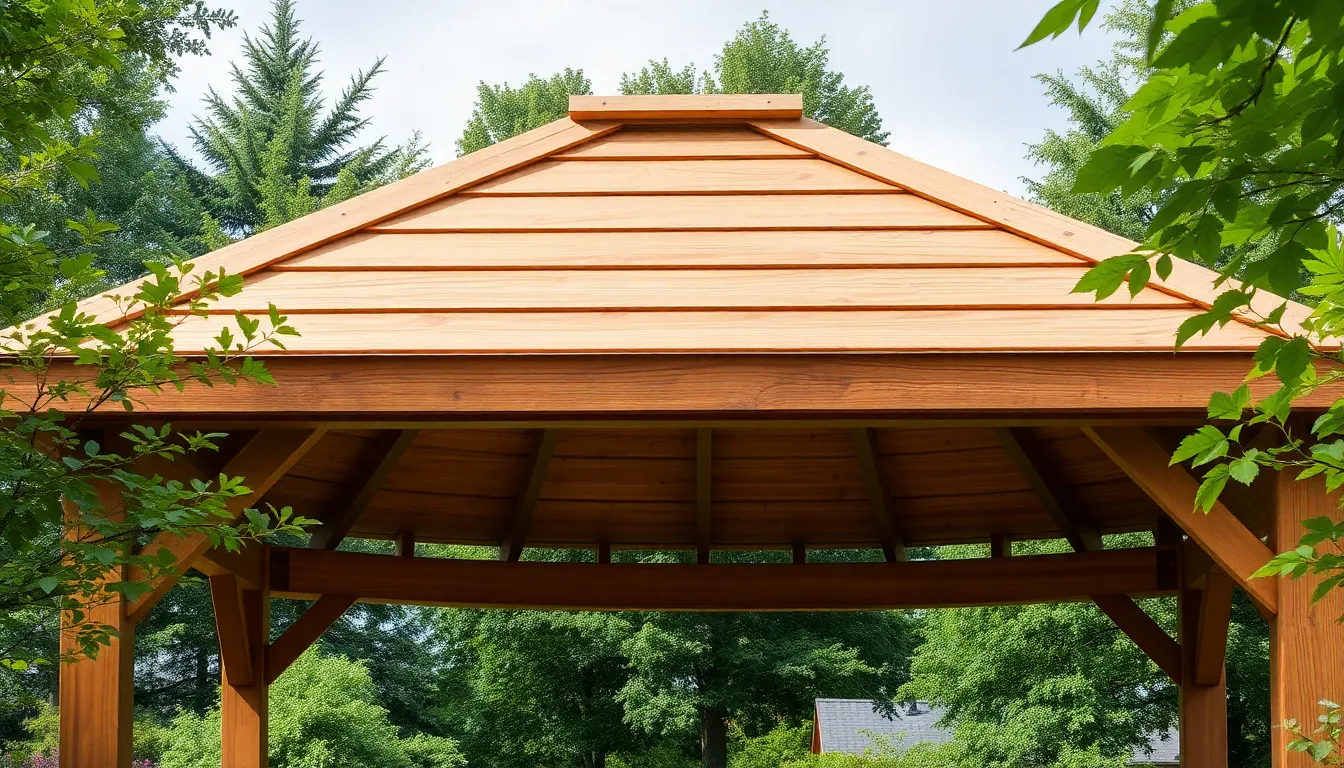When it comes to outdoor living spaces, a gazebo can be the crown jewel of any backyard. But let’s face it—nobody wants a roof that looks like it just rolled off the assembly line. It’s time to elevate that gazebo with some creative roof ideas that’ll make neighbors green with envy and squirrels take note!
Gazebo Roof Ideas
Choosing the right gazebo roof style can significantly enhance outdoor spaces. Several popular designs offer both aesthetics and functionality.
Gable Roof
Gable roofs feature two sloping sides that meet at a ridge, creating a triangular shape. This design allows for efficient rain and snow runoff. An appealing aspect of gable roofs is their versatility; they suit various materials, including wood, metal, and shingles. Many homeowners prefer gable roofs for their classic look and added height. This style often accommodates tall structures and ventilation openings, improving airflow.
Hip Roof
Hip roofs have slopes on all four sides, meeting at a peak. This design provides superior stability and wind resistance, making it an excellent choice for regions with harsh weather. The angled sides add a visually pleasing element, giving a more finished appearance to the gazebo. Homeowners value hip roofs for their efficient drainage. Sufficient overhangs protect against rain and sun, ensuring shade and shelter.
Pavilion Roof
Pavilion roofs feature a flat center with gentle sloping sides, offering a contemporary look. This style often emphasizes spaciousness, allowing for higher ceilings without compromising structural integrity. Commonly constructed with durable materials, pavilion roofs provide solid protection against elements. Homeowners appreciate the unique design for its open feel, fostering a welcoming atmosphere. Many also prefer this style for its compatibility with various outdoor furnishings and decorations.
Materials for Gazebo Roofs


Selecting the right material for a gazebo roof enhances both aesthetics and functionality. Various materials provide different benefits, ensuring a fit for diverse preferences.
Wood
Wood provides a classic and natural appearance. Its versatility allows for customization in design and color. Cedar and redwood are popular choices due to their resistance to decay and insects. Maintenance is essential; regular staining can prolong wood’s lifespan and appearance. A wooden roof complements traditional gazebo styles and integrates well with natural surroundings.
Metal
Metal roofs offer durability and a modern look. Materials like aluminum and galvanized steel resist rust, ensuring longevity. Lightweight characteristics ease installation, while reflective surfaces contribute to energy efficiency. Metal roofs handle extreme weather well, providing excellent wind and snow resistance. They can come in various colors, enhancing visual appeal.
Vinyl
Vinyl roofing combines affordability with low maintenance. This lightweight material resists fading, cracking, and warping over time. Easy installation complements quick project timelines. Available in numerous colors, vinyl roofs can match various gazebo styles effortlessly. Their longevity and aesthetic versatility make them a popular choice for many homeowners.
Enhancing Your Gazebo Roof
Optimizing a gazebo roof adds both aesthetic value and functionality to outdoor spaces. Unique features can transform a standard gazebo into a captivating focal point.
Adding Skylights
Incorporating skylights increases natural light and enhances the gazebo’s ambiance. Skylights allow for sunlight to flood the space, promoting a bright and inviting atmosphere. Choose from various shapes and sizes to complement the gazebo’s design. Opt for double-glazed options, which provide better insulation while reducing heat gain during summer months. Proper placement ensures that light illuminates key areas without disrupting comfort. With a well-designed skylight, homeowners enjoy a connection to the outdoors while being sheltered from the elements.
Installing Vents
Installing vents improves air circulation and temperature control in the gazebo. Adequate ventilation prevents excessive heat buildup, creating a more comfortable environment during warmer months. Roof vents can be strategically located to promote airflow while maintaining the gazebo’s visual appeal. Options such as ridge vents or gable vents blend seamlessly into the roofline, adding functionality without compromising design. Selecting decorative vent covers enhances aesthetic value while ensuring practical usage. A properly ventilated gazebo remains enjoyable year-round, creating a perfect retreat for relaxation or entertaining.
Design Considerations
Designing a gazebo roof involves careful consideration of color, style, and weather resistance. These factors play significant roles in both aesthetics and functionality.
Color and Style
Choosing the right color and style enhances the gazebo’s overall appearance. Vibrant hues stand out in gardens, while neutral colors blend seamlessly with natural surroundings. Materials like wood can be stained in various tones to match existing outdoor decor. Bright roofs attract attention, while muted tones offer a calming effect. Moreover, selecting styles that complement the home’s architecture creates a cohesive look across the property. Individual preferences should drive these choices, ensuring the gazebo reflects the owner’s personality.
Weather Resistance
Weather resistance remains crucial for gazebo roofs to endure harsh elements. Durable materials such as metal and specially treated wood resist moisture, snow, and sun damage. Metal roofs, like aluminum, offer long-lasting protection against wind and rain. The right insulation enhances energy efficiency, further protecting the gazebo from extreme temperatures. Regular maintenance ensures all roofing options remain resilient throughout changing seasons. Homeowners should prioritize both material quality and structural design to extend the gazebo’s lifespan while maintaining its beauty.


